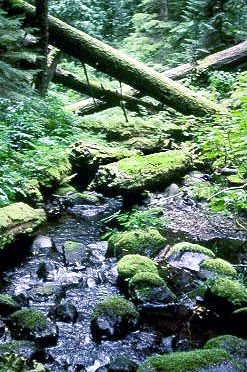
Little Streams Play Vital Role in Clean Water Supply
MONITOR Wire Services
 |
MONITOR Wire Services |
|
 Streams
are not gutters that simply deliver nutrients to lakes, oceans and bays. Streams are vibrant ecosystems, and the smallest streams remove as much as half of the inorganic nitrogen that enters them, according to researchers from more than a dozen institutions who studied streams over the course of two years.
Streams
are not gutters that simply deliver nutrients to lakes, oceans and bays. Streams are vibrant ecosystems, and the smallest streams remove as much as half of the inorganic nitrogen that enters them, according to researchers from more than a dozen institutions who studied streams over the course of two years.
Human activities, such as fertilizer application and the burning of fossil fuels, result in excess nitrogen entering streams, changing water quality downstream, such as in the Chesapeake Bay or Gulf of Mexico. The approach to minimizing nitrogen contamination in these waterways has been mainly terrestrial, since the processes responsible for nitrogen uptake and release in streams has been a black box. But a science workshop in 1995 led to a new way to track nitrogen through a stream's biological systems. "The bottom line is streams have an impact. They can remove as much as 50 percent of the inorganic nitrogen. So anything we do to streams to modify them will impact the nitrogen that reaches rivers, lakes, bays and oceans," says Jack Webster of Virginia Tech, one of the researchers. The finding could have important consequences for land-use policies. What happens to the nitrogen that is removed from streams? The researchers found that some of the nitrogen is converted to nitrogen gas through denitrification processes and the rest becomes nutrition for algae, bacteria and fungi, which then become food for aquatic insects and fish. As the plant or organism dies, the nitrogen can then end up as slowly decomposing materials that settle in the stream or lake sediments, Webster says. He explains that plant life, particularly algae, is a very important nitrogen-user in some streams -- such as in Alaska, Arizona and Kansas, where there are few trees to block the sun. Alternatively, in forested streams, such as those in Oregon and North Carolina, nitrogen is removed by fungi and bacteria, which do not photosynthesize, but decompose dead organic material settled on the stream bottom, also a food resource for some aquatic insects. The experiment involved the simultaneous study of ten streams from Puerto Rico to Alaska. Jennifer Tank of the University of Notre Dame said that one site in Arizona site presented unique problems. Located only 35 miles from Phoenix, Sycamore Creek required that a permanent camp be set up "to ensure that equipment was not stolen, shot at, or stepped on by cows," she said. At least two people were required to be in the field full-time for 43 days. Three dozen relatives and friends of Arizona State University researchers were recruited to help. The results were reported in the April 6 issue of Science, in the article "Control of Nitrogen Export from Watersheds by Headwater Streams."
Albion Monitor
April 13, 2001 (http://www.monitor.net/monitor) All Rights Reserved. Contact rights@monitor.net for permission to use in any format. |